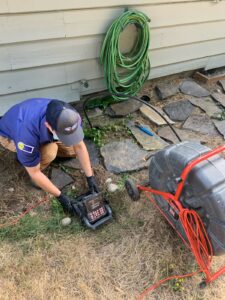Homeownership is a big responsibility, and it doesn’t take much to get property owners to see the value of keeping drain and sewer lines clean and free of debris. However, homeowners ask some common questions when researching sewer cleaning, and we’ve answered a few of them here.
Who Is Responsible for Cleaning the Sewer Line?
Your property’s plumbing consists of a series of pipes that bring water into and out of your home. Drain lines take the wastewater away from your home and channel it into a sewer line that connects with your city sewer system. Those drain lines and the sanitary sewer line are located on your property. In most cases, you’re responsible for cleaning the sewer line that connects your home’s plumbing to the city sewer system.
How Do I Know If I Need Sewer Cleaning?
While sewer backups are nasty, they usually don’t happen without warning. One sign that your sewer line needs cleaning is slow drainage. This is very noticeable when you flush the toilet and its contents linger. Another telltale sign that your sewer line needs cleaning is the smell of sewage coming from your freshly cleaned bathroom. Bubbles that gurgle out of one appliance after you’ve just used another are also a signal that you need to call a plumber to clean your sewer line. Your lawn looks lovely, and there are patches of wet grass even though it hasn’t rained in a week. A sewage backup that has flooded your yard can be the culprit.
How Do You Perform Sewer Cleaning?
Professional drain cleaning specialists have access to the latest diagnostic and cleaning equipment on the market. Technicians will often check the sewer line through video camera inspection when you get a sewer line cleaning service. After discovering the nature of the problem, the technician will opt to remove the clog via a mechanical or chemical solution or a combination of both. Some companies use highly pressurized water to clean away grease and sediment in sewer lines in a procedure called water jetting.
What if it isn’t enough?
A few different issues can cause sewer line problems. A serious one occurs when tree roots penetrate the sewer line. In some instances, clearing tree roots from the line isn’t feasible, and the sewer line must be replaced.
How Can I Protect My Drain Lines?
The best way to protect your drains and sewer line from clogs after cleaning is to avoid putting things down the drain that your drains aren’t designed to receive. Shield your plumbing by installing screens at each drain. Avoid flushing these things down the toilet or pouring them down kitchen sinks.
– Grease
– Baby wipes
– Hair
– Kitty litter
– Coffee grounds
– Paint
No one wants to come home to a sewer backup. These problems are messy, smelly, and expensive to clean up properly. The good news is that you can reduce your risk of severe clogs and sewer backups with regular sewer line cleaning. Need more information about us? Give us a call. Our licensed technicians are waiting to help.
